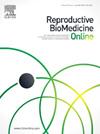Decoding embryo development: the effect of clinical variables in morphokinetics and artificial intelligence quality scoring
IF 3.7
2区 医学
Q1 OBSTETRICS & GYNECOLOGY
引用次数: 0
Abstract
Research question
Do morphokinetic events (MKS) and patient parameters affect resulting embryo quality scores, and how does this relate to pregnancy outcomes as assessed by a time-lapse incubator using an artificial intelligence (AI) embryologist support tool?
Design
Retrospective study analysing data from 6024 embryos retrieved over 1636 cycles. The dataset comprised 3778 donor oocytes and 2246 autologous oocytes. Additionally, 3309 biopsied embryos were included in the PGT-A analysis. Outcome data were derived from 1355 transferred embryos. All embryos were assessed using a time lapse-based AI system (CHLOE EQ™), which assigns an embryo quality score from 0 to 1 based upon established morphokinetic benchmarks. The AI embryo quality score was assigned on day 5 of embryo development. Analysed patient parameters were patient age, fresh or frozen oocyte status and use of own or donor oocytes. Twenty-three MKS were analysed. The effect of morphokinetics on the incidence of ploidy was also assessed.
Results
Clinical outcomes are affected by embryo quality and MKS as detected by an AI software. Time to expanded blastocyst (tEB) was the morphokinetic parameter with the strongest correlation coefficient with embryo quality score (–0.816). As the patient's age increases by 1 unit, embryo quality score decreases significantly and time to achieve expanded blastocyst increases by 0.47 h. Similar trends were observed with frozen oocytes, which showed a 2.1 h increase in tEB compared with fresh oocytes. Autologous oocytes were associated with a 6.08 h longer tEB compared with donor oocytes. Additionally, euploid embryos reached tEB 4.72 h earlier than aneuploid embryos. For a one unit increase in embryo quality score, the odds of achieving clinical pregnancy increased by 21.7% and the odds of achieving ongoing pregnancy or live birth increased by 18.5%. Oocyte sources had an effect on miscarriage rates; the use of frozen oocytes resulted in higher miscarriage rates than observed when fresh oocytes were used.
Conclusions
AI can successfully evaluate embryo quality and can assist embryologists in decision making. Furthermore, this AI model can delineate the effect of various clinical factors on resulting outcomes.
解码胚胎发育:临床变量对形态动力学和人工智能质量评分的影响。
研究问题:形态动力学事件(MKS)和患者参数是否会影响最终的胚胎质量评分,以及这与使用人工智能(AI)胚胎学家支持工具的延时培养箱评估的妊娠结局有什么关系?设计:回顾性研究分析了1636个周期内6024个胚胎的数据。该数据集包括3778个供体卵母细胞和2246个自体卵母细胞。此外,3309个活检胚胎被纳入PGT-A分析。结果数据来自1355个移植胚胎。所有胚胎都使用基于延时的人工智能系统(CHLOE EQ™)进行评估,该系统根据已建立的形态动力学基准,将胚胎质量评分从0到1。在胚胎发育第5天进行AI胚胎质量评分。分析患者参数包括患者年龄、新鲜或冷冻卵母细胞状态、使用自己或供体卵母细胞。分析了23个MKS。形态动力学对倍性发生率的影响也进行了评估。结果:人工智能软件检测胚胎质量和MKS影响临床结果。胚泡膨大时间(tEB)是与胚胎质量评分相关性最强的形态动力学参数(-0.816)。患者年龄每增加1个单位,胚胎质量评分明显下降,实现囊胚膨大的时间增加0.47 h。冷冻卵母细胞的tEB也有类似的趋势,与新鲜卵母细胞相比,tEB增加2.1 h。与供体卵母细胞相比,自体卵母细胞的tEB延长了6.08 h。此外,整倍体胚胎比非整倍体胚胎早4.72 h到达tEB。胚胎质量评分每增加一个单位,临床妊娠的几率增加21.7%,持续妊娠或活产的几率增加18.5%。卵母细胞来源对流产率有影响;使用冷冻卵母细胞比使用新鲜卵母细胞导致更高的流产率。结论:人工智能可成功评价胚胎质量,可辅助胚胎学家进行决策。此外,该人工智能模型可以描述各种临床因素对最终结果的影响。
本文章由计算机程序翻译,如有差异,请以英文原文为准。
求助全文
约1分钟内获得全文
求助全文
来源期刊

Reproductive biomedicine online
医学-妇产科学
CiteScore
7.20
自引率
7.50%
发文量
391
审稿时长
50 days
期刊介绍:
Reproductive BioMedicine Online covers the formation, growth and differentiation of the human embryo. It is intended to bring to public attention new research on biological and clinical research on human reproduction and the human embryo including relevant studies on animals. It is published by a group of scientists and clinicians working in these fields of study. Its audience comprises researchers, clinicians, practitioners, academics and patients.
Context:
The period of human embryonic growth covered is between the formation of the primordial germ cells in the fetus until mid-pregnancy. High quality research on lower animals is included if it helps to clarify the human situation. Studies progressing to birth and later are published if they have a direct bearing on events in the earlier stages of pregnancy.
 求助内容:
求助内容: 应助结果提醒方式:
应助结果提醒方式:


